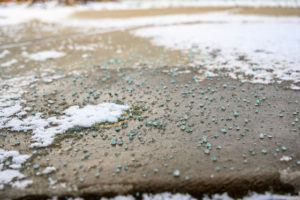Winter Salt Awareness Week is Jan. 22-26. The Wisconsin DNR and Wisconsin Salt Wise invite the public to take time to learn more about the impacts of road salt on drinking water and infrastructure.
What The Research Shows
Although salt keeps Wisconsin roads safe during winter, using more salt than needed comes at a price. In Wisconsin and much of the U.S., chlorides from salt are infiltrating lakes, streams, and groundwater. According to Wisconsin Salt Wise, one teaspoon of salt is all it takes to make five gallons of water toxic for freshwater organisms.
The DNR measures chloride levels in Wisconsin rivers over time, monitoring cumulative chloride loading results at 26 of the state’s largest river systems. Recent studies have shown a steep increase in chloride loads. In the early 2000s, the DNR measured about 600,000 tons of chlorides annually. By 2018, that number increased to nearly 800,000 tons per year. Fifty lakes and one stream in Wisconsin have been designated impaired by high salt concentrations.
“All of the 43 long-term trend water quality monitoring sites across Wisconsin are showing increases in chlorides,” said Shannon Haydin, DNR Storm Water Section Manager. “Chlorides persist in the environment forever and cause significant impacts to fish, aquatic life and human health. In Wisconsin, we see evidence of Fresh Water Salinization Syndrome, a condition where our freshwater becomes more like ocean water in terms of saltiness. Now is the time to make a change and reduce salt use when we can.”
These increased chloride loads are partly due to road salting, but chlorides also enter Wisconsin waters because of water softeners and fertilizers. Find out if your softener is salt-wise with this diagnostic tool.
Increased chloride levels, including environmental and economic effects, significantly impact our daily lives. Nationwide, winter salt causes $5 billion in damage to infrastructure each year, causing corrosion on bridges, roads and other infrastructure. Road salt can also impact pets by causing irritated paws or other health concerns if ingested.
Salt Tips For You
- Shovel: Clear walkways and other areas before the snow turns to ice. The more snow removed manually, the less salt you will need and the more effective it will be.
- Scatter: When using salt, scatter it so there is space between the grains. A 12-ounce coffee mug of salt is enough to treat an entire 20-foot driveway or 10 sidewalk squares.
- Switch: Salt won’t work when pavement temperatures drop below 15 degrees. Switch to sand for traction or a different ice melter that works at lower temperatures.


